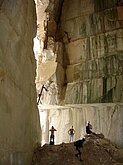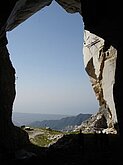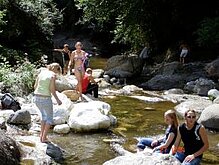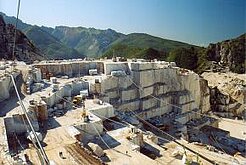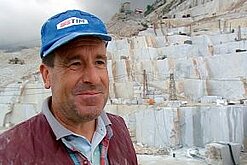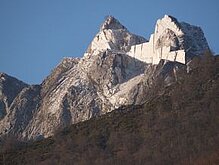A short history of marble
by Peter Rosenzweig
Within eyeshot of the Campo lies the mountain Monte Altissimo which in part consists of very white marble. This material is known all over the world as Carrara marble. It has greatly influenced the lives of the people of this region and is very fascinating.
Most of the time you will only find Ordinario marble, which is mainly used for construction etc. It is quarried in blocks of all sizes. But sculptors have always been more interested in the best quality marble, the Statuario. This particularly white marble, with a faint golden tint (dorato) is very translucent and nearly devoid of veins and to this day it is highly sought after.
Azzano is situated on the north-western border of present-day Tuscany, the former empire of the Medici princes and popes, patrons of luminary Michelangelo Buonarroti.
In order to be independent of the expensive marble import from the then neighbour state Carrara/Liguria – where marble was already quarried in times before Christ was born - Michelangelo was sent to Azzano di Seravezza at the beginning of the 16th century to develop the Tuscan marble deposit till then unutilised.
He spent 3 years here, building streets, bridges and routes of transport. Thus Michelangelo laid the foundation of marble quarrying in our valley. You can still see traces of his work today. But unfortunately he himself wasn't to see the products of the quarry activities within his lifetime. The industrial quarrying of marble in our valley only started in recent history.
Up until Michelangelo's times the people of our valley obtained marble in boulders of varied sizes directly from the riverbed of the Serra which has its source on the Monte Altissimo (1560m). The river changes its name after it reaches the plain, from there it is called “Versilia”, fiume Versilia. Nowadays the entire region between the cities Massa and Pietrasanta takes its name from this: la Versilia. The bordering mountain range with the marble deposit is called Alta Versilia (Alto/a = high, Altissimo = highest)
During the 18th century our mountain experienced an exceptional natural event. At about 1100m it opened up with a thunderous roar and revealed a very white spot: the “Tacca Bianca”. No effort was spared to build routes of transport up to this height in order to snatch from the mountain the Statuario marble which is to this day in great demand.
When visiting the old places of excavation, walking on adventurous paths we come to appreciate the hard work and the grandiose achievement of the cavatori (quarry worker).
Quarrying on the Monte Altissimo came more or less to an end in the 1970ies. The competition of other, cheaper sites which were easier to reach and the emerging fashion of using harder materials like granite became too big.
Nowadays you will discover Statuario only as remnants in former quarries which are hard to access or – with a bit of luck – in the riverbed of the Serra where our courses begin.
When Saudi-Arabia wanted to pave an international airport with Statuario they tried to reopen the Tacca Bianca cave of the Altissimo, but the start of the first Gulf war got in the way of the operation.
Thus enormous amounts of the most precious material slumber on in fascinating marble caves.
Today you can buy Statuario in nearby Carrara. 1 ton of Ordinario marble costs between €100 and €200. A ton of Statuario can cost €2.000 and more.
To a sculptor the fascination of marble is manifold: Its fine crystalline structure makes it transparent and it is available in blocks of variable sizes. Further plus points are its formability, its reliability and its colour, white.
Since its primary material, namely calcium carbonate, is compatible with the human body it is not harmful for humans to breathe in its dust and particles.
The emperors of ancient Rome ordered their slaves to blow marble dust into the air where they used to promenade because they already knew of the beneficial effect marble had on the people living near the quarries: a long life and robust health, to name but two.
In geology marble is known as metamorphic calcium carbonate. It originated as a thick sediment layer on the floor of prehistoric seas (amongst others it is made up of dead crustaceans and shells) which in millions of years was pushed deep into the earth. There it was heated to about 400°C (752 Fahrenheit) and then was pushed up to the surface again due to tectonic plate shifts. With a pressure of tens of thousands of bar the former sediment layer was crystallised into marble during its cooling down.
Thus follows: Lime > metamorphosis = Heat/Cooling down/ Pressure > Marble. This is why marble is so precious.
Near Carrara you can find the largest region of purest marble known in the world, 99,999% calcite. You can recognise Carrara and Altissimo marble by its particularly fine crystalline structure, its tiny crystals are near impossible to distinguish by the human eye.
Marble can also be found in other countries. E.g. Greek or Turkish marble have a much coarser structure but their whiteness is similar to Italian marble.

